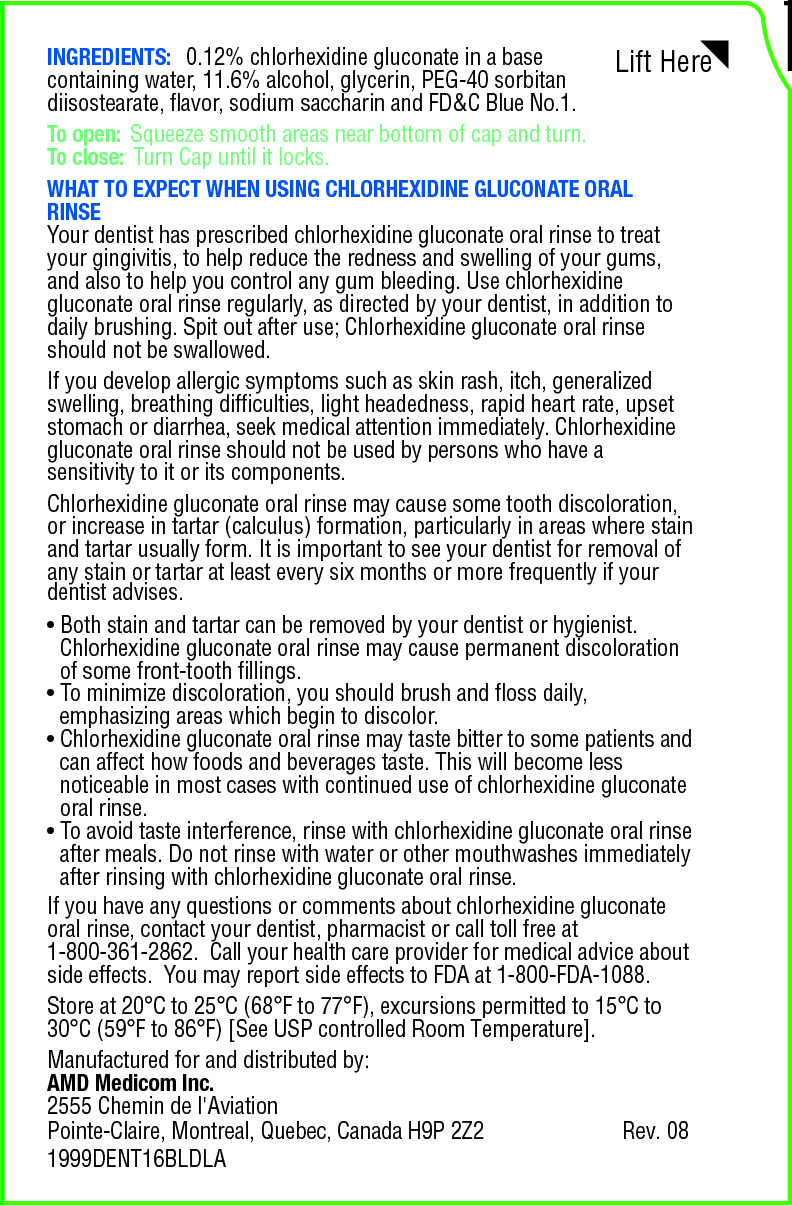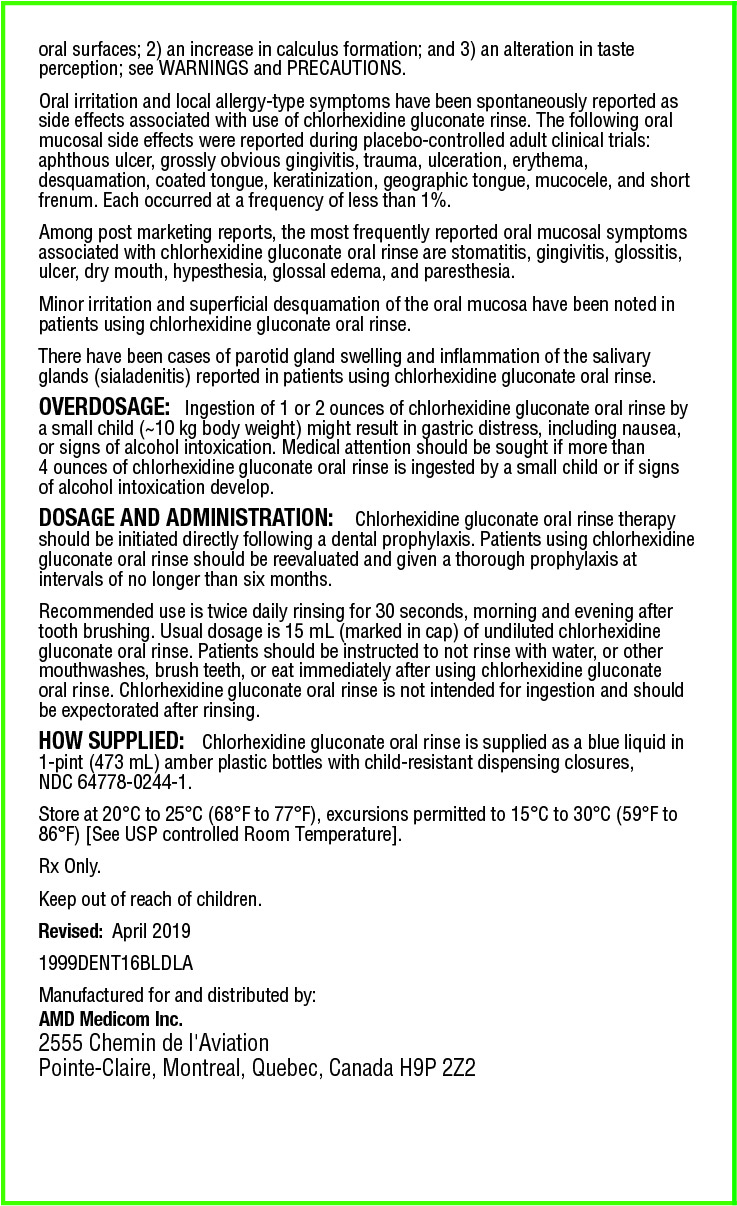CHLORHEXIDINE GLUCONANTE rinse
Chlorhexidine Gluconante by
Drug Labeling and Warnings
Chlorhexidine Gluconante by is a Prescription medication manufactured, distributed, or labeled by AMD Medicom Inc.. Drug facts, warnings, and ingredients follow.
Drug Details [pdf]
-
Clinical Pharmacology
CLINICAL PHARMACOLOGY: Chlorhexidine gluconate oral rinse provides antimicrobial activity during oral rinsing. The clinical significance of chlorhexidine gluconate oral rinse’s antimicrobial activities is not clear. Microbiological sampling of plaque has shown a general reduction of counts of certain assayed bacteria, both aerobic and anaerobic, ranging from 54-97% through six months use.
Use of chlorhexidine gluconate oral rinse in a six month clinical study did not result in any significant changes in bacterial resistance, overgrowth of potentially opportunistic organisms or other adverse changes in the oral microbial ecosystem. Three months after chlorhexidine gluconate oral rinse use was discontinued, the number of bacteria in plaque had returned to baseline levels and resistance of plaque bacteria to chlorhexidine gluconate was equal to that at baseline -
Pharmacokinetics
Pharmacokinetics: Pharmacokinetic studies with chlorhexidine gluconate oral rinse indicate approximately 30% of the active ingredient, chlorhexidine gluconate, is retained in the oral cavity following rinsing. This retained drug is slowly released in the oral fluids. Studies conducted on human subjects and animals demonstrate chlorhexidine gluconate is poorly absorbed from the gastrointestinal tract. The mean plasma level of chlorhexidine gluconate reached a peak of 0.206 mcg/g in humans 30 minutes after they ingested a 300 mg dose of the drug. Detectable levels of chlorhexidine gluconate were not present in the plasma of these
subjects 12 hours after the compound was administered. Excretion of chlorhexidine gluconate occurred primarily through the feces (~90%). Less than 1% of the chlorhexidine gluconate ingested by these subjects was excreted in the urine. - Contraindications
-
Pregnancy
Pregnancy: Teratogenic Effects Pregnancy Category B. Reproduction studies have been performed in rats and rabbits at chlorhexidine gluconate doses up to 300 mg/kg/day and 40 mg/kg/day respectively, and have not revealed evidence of harm to fetus. However, adequate and well-controlled studies in pregnant women have not been done. Because animal reproduction studies are not always predictive of human response, this drug should be used during pregnancy only if clearly needed.
-
Nursing Mothers
Nursing Mothers: It is not known whether this drug is excreted in human milk. Because many drugs are excreted in human milk, caution should be exercised when chlorhexidine gluconate oral rinse is administered to nursing women.
In parturition and lactation studies with rats, no evidence of impaired parturition or of toxic effects to suckling pups was observed when chlorhexidine gluconate was administered to dams at doses that were over 100 times greater than that which would result from a person’s ingesting 30 mL (2 capfuls) of chlorhexidine gluconate oral rinse per day. - Pediatric
-
Carcinogenesis, Mutagenesis, and Impairment of Fertility
Carcinogenesis, Mutagenesis, and Impairment of Fertility: In a drinking water study in rats, carcinogenic effects were not observed at doses up to 38 mg/kg/day. Mutagenic effects were not observed in two mammalian in vivo mutagenesis studies with chlorhexidine gluconate. The highest doses of chlorhexidine used in a mouse dominant-lethal assay and a hamster cytogenetics test were
1000 mg/kg/day and 250 mg/kg/day, respectively. No evidence of impaired fertility was observed in rats at doses up to 100 mg/kg/day. -
Adverse Reactions
ADVERSE REACTIONS: The most common side effects associated with chlorhexidine gluconate oral rinses are: 1) an increase in staining of teeth and other oral surfaces; 2) an increase in calculus formation; and 3) an alteration in taste perception; see WARNINGS and PRECAUTIONS.
Oral irritation and local allergy-type symptoms have been spontaneously reported as side effects associated with use of chlorhexidine gluconate rinse. The following oral mucosal side effects were reported during placebo-controlled adult clinical trials:
aphthous ulcer, grossly obvious gingivitis, trauma, ulceration, erythema, desquamation, coated tongue, keratinization, geographic tongue, mucocele, and short frenum. Each occurred at a frequency of less than 1%.
Among post marketing reports, the most frequently reported oral mucosal symptoms associated with chlorhexidine gluconate oral rinse are stomatitis, gingivitis, glossitis, ulcer, dry mouth, hypesthesia, glossal edema, and paresthesia.
Minor irritation and superficial desquamation of the oral mucosa have been noted in patients using chlorhexidine gluconate oral rinse.
There have been cases of parotid gland swelling and inflammation of the salivary glands (sialadenitis) reported in patients using chlorhexidine gluconate oral rinse. -
Overdosage
OVERDOSAGE: Ingestion of 1 or 2 ounces of chlorhexidine gluconate oral rinse by a small child (~10 kg body weight) might result in gastric distress, including nausea, or signs of alcohol intoxication. Medical attention should be sought if more than 4 ounces of chlorhexidine gluconate oral rinse is ingested by a small child or if signs of alcohol intoxication develop.
-
Dosage & Administration
DOSAGE AND ADMINISTRATION: Chlorhexidine gluconate oral rinse therapy should be initiated directly following a dental prophylaxis. Patients using chlorhexidine gluconate oral rinse should be reevaluated and given a thorough prophylaxis at intervals of no longer than six months.
Recommended use is twice daily rinsing for 30 seconds, morning and evening after tooth brushing. Usual dosage is 15 mL (marked in cap) of undiluted chlorhexidine gluconate oral rinse. Patients should be instructed to not rinse with water, or other mouthwashes, brush teeth, or eat immediately after using chlorhexidine gluconate oral rinse. Chlorhexidine gluconate oral rinse is not intended for ingestion and should be expectorated after rinsing.
- How Supplied
- Storage and Handling
-
WHAT TO EXPECT WHEN USING CHLORHEXIDINE GLUCONATE ORAL RINSE
WHAT TO EXPECT WHEN USING CHLORHEXIDINE GLUCONATE ORAL RINSE
Your dentist has prescribed chlorhexidine gluconate oral rinse to treat your gingivitis, to help reduce the redness and swelling of your gums, and also to help you control any gum bleeding. Use chlorhexidine gluconate oral rinse regularly, as directed by your dentist, in addition to daily brushing. Spit out after use; Chlorhexidine gluconate oral rinse should not be swallowed.
If you develop allergic symptoms such as skin rash, itch, generalized swelling, breathing difficulties, light headedness, rapid heart rate, upset stomach or diarrhea, seek medical attention immediately. Chlorhexidine gluconate oral rinse should not be used by persons who have a sensitivity to it or its components.
Chlorhexidine gluconate oral rinse may cause some tooth discoloration, or increase in tartar (calculus) formation, particularly in areas where stain and tartar usually form. It is important to see your dentist for removal of any stain or tartar at least every six months or more frequently if your dentist advises.
Both stain and tartar can be removed by your dentist or hygienist. Chlorhexidine gluconate oral rinse may cause permanent discoloration of some front-tooth fillings.
To minimize discoloration, you should brush and floss daily, emphasizing areas which begin to discolor.
Chlorhexidine gluconate oral rinse may taste bitter to some patients and can affect how foods and beverages taste. This will become less noticeable in most cases with continued use of chlorhexidine gluconate oral rinse.
To avoid taste interference, rinse with chlorhexidine gluconate oral rinse after meals. Do not rinse with water or other mouthwashes immediately after rinsing with chlorhexidine gluconate oral rinse.
If you have any questions or comments about chlorhexidine gluconate oral rinse, contact your dentist, pharmacist or call toll free at
1-800-361-2862. Call your health care provider for medical advice about side effects. You may report side effects to FDA at 1-800-FDA-1088. - Inactive Ingredients
-
Indications
INDICATION: Chlorhexidine gluconate oral rinse is indicated for use between dental visits as part of a professional program for the treatment of gingivitis as characterized by redness and swelling of the gingivae, including gingival bleeding upon probing. Chlorhexidine gluconate oral rinse has not been tested among patients with acute necrotizing ulcerative gingivitis (ANUG). For patients having coexisting gingivitis and periodontitis; see PRECAUTIONS.
- Full Label NDC: 64778-0244-1
- Principal Panel NDC: 64778-0244-1
-
INGREDIENTS AND APPEARANCE
CHLORHEXIDINE GLUCONANTE
chlorhexidine gluconante rinseProduct Information Product Type HUMAN PRESCRIPTION DRUG Item Code (Source) NDC: 64778-0244 Route of Administration ORAL Active Ingredient/Active Moiety Ingredient Name Basis of Strength Strength CHLORHEXIDINE GLUCONATE (UNII: MOR84MUD8E) (CHLORHEXIDINE - UNII:R4KO0DY52L) CHLORHEXIDINE GLUCONATE 1.2 mg in 1 mL Inactive Ingredients Ingredient Name Strength ALCOHOL (UNII: 3K9958V90M) SACCHARIN SODIUM (UNII: SB8ZUX40TY) WATER (UNII: 059QF0KO0R) GLYCERIN (UNII: PDC6A3C0OX) PEG-40 SORBITAN DIISOSTEARATE (UNII: JL4CCU7I1G) FD&C BLUE NO. 1 (UNII: H3R47K3TBD) Product Characteristics Color blue Score Shape Size Flavor MINT Imprint Code Contains Packaging # Item Code Package Description Marketing Start Date Marketing End Date 1 NDC: 64778-0244-1 473 mL in 1 BOTTLE, PLASTIC; Type 0: Not a Combination Product 06/02/2006 Marketing Information Marketing Category Application Number or Monograph Citation Marketing Start Date Marketing End Date ANDA ANDA077789 06/02/2006 Labeler - AMD Medicom Inc. (256880576) Registrant - AMD Medicom Inc. (256880576)
© 2025 FDA.report
This site is not affiliated with or endorsed by the FDA.





